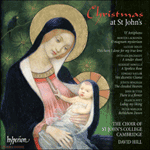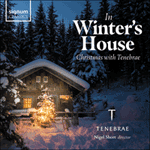This is the motet
Vox dicentis: Clama by Edward Naylor (1867–1934), who was organist of Emmanuel College, Cambridge. Apart from an extensive body of church music, he also wrote an opera (
The Angelus, performed at Covent Garden in 1904), was one of the earliest advocates of musical authenticity, and an authority on Shakespeare and music.
Vox dicentis: Clama was composed in 1911 for King’s College, Cambridge, and sets texts from Isaiah describing the voice of one crying out in the wilderness. It is an extended work, in four distinct sections, with the choral textures frequently dividing into lush eight-part writing that consciously used the resonant acoustic of King’s chapel. The striking opening is almost operatic with a declamatory bass line and dramatic interjections from the rest of the choir. Particularly effective too is the final pastoral-like section, which features a solo treble setting words dwelling on the image of Christ the Good Shepherd, and an ending exploiting harmonic suspensions of caressing beauty.
from notes by Andrew Burn © 2006
Voici le motet
Vox dicentis: Clama d’Edward Naylor (1867–1934). Organiste d’Emmanuel College (Cambridge) et auteur d’un vaste corpus de musique liturgique, il écrivit aussi un opéra (
The Angelus, donné à Covent Garden en 1904), fut l’un des tout premiers défenseurs de l’authenticité musicale et fit autorité sur Shakespeare et la musique. Composé en 1911 pour le King’s College de Cambridge,
Vox dicentis: Clama met en musique des textes d’Isaïe sur la voix de quelqu’un criant dans le désert. C’est une œuvre vaste, en quatre sections distinctes, où les textures chorales se scindent souvent en une généreuse écriture à huit parties usant sciemment de l’acoustique résonante de la chapelle du King’s College. L’ouverture saisissante est presque opératique, avec sa ligne de basse déclamatoire et ses dramatiques interjections émanant du reste du chœur. Tout aussi efficace, la section finale, de type pastorale, met en scène un treble solo chantant des paroles qui s’attardent sur l’image du Christ bon berger, et une conclusion exploitant des suspensions harmoniques d’une beauté caressante.
extrait des notes rédigées par Andrew Burn © 2006
Français: Hypérion
Diese ist die Motette
Vox dicentis: Clama von Edward Naylor (1867–1934), der Organist am Emmanuel College, Cambridge war. Neben einem umfangreichen Kirchenmusikœuvre schrieb er auch eine Oper (
The Angelus, die 1904 in Covent Garden aufgeführt wurde). Edward Naylor gehörte zu den Ersten, die sich für die Aufführungspraxis Alter Musik einsetzten. Zudem war er eine Koryphäe in Sachen Shakespeare und Musik.
Vox dicentis: Clama wurde 1911 für das King’s College, Cambridge komponiert und zieht einen Text aus Jesaja heran, der die aus der Wüste rufende Stimme des Predigers beschreibt. Naylors Stück ist lang, in vier deutlich unterschiedliche Abschnitte unterteilt und enthält häufig satte achtstimmige Chorpassagen, die bewusst die nachhallende Akustik der Kirche des King’s College ausnutzen. Der beeindruckende Anfang mit seiner deklamierenden Basslinie und den theatralischen Einwürfen vom Rest des Chores wirkt fast wie eine Oper. Besonders wirksam erweist sich auch der pastorale letzte Abschnitt, in dem eine solistische Sopranstimme das im Text zum Ausdruck kommende Bild von Christus als den Guten Hirten musikalisch nachzeichnet, und der Schluss aus harmonischen Vorhalten von inniger Schönheit.
aus dem Begleittext von Andrew Burn © 2006
Deutsch: Elke Hockings


 Christmas at St John's Cambridge
Christmas at St John's Cambridge In winter's house
In winter's house
